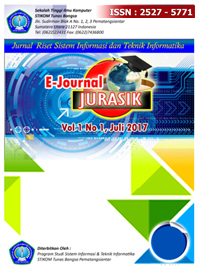Algoritma K-Medoids untuk Mengelompokkan Desa yang Memiliki Fasilitas Sekolah di Indonesia
Abstract
Full Text:
PDFReferences
Riyadus Solihin and Achmad Ryan Fauzi, “Penurunan Minat bersekolah di SD Negeri dibandingkan SD Islam,” Briliant J. Ris. dan Konseptual, vol. 2, no. 3, pp. 392–401, 2017.
W. A. Triyanto, “Algoritma K-Medoids Untuk Penentuan Strategi Pemasaran,” Simetris, vol. 6, no. 1, pp. 183–188, 2015.
D. F. Pramesti, M. T. Furqon, and C. Dewi, “Implementasi Metode K-Medoids Clustering Untuk Pengelompokan Data Potensi Kebakaran Hutan / Lahan Berdasarkan Persebaran Titik Panas ( Hotspot ),” J-ptiik, vol. 1, no. 9, pp. 723–732, 2017.
S. Defiyanti and M. Jajuli, “Optimalisasi K - Medoid Dalam Pengklasteran Mahasiswa Pelamar Beasiswa Dengan Cubic Clustering Criterion,” TEKNOSI, vol. 03, no. 01, pp. 211–218, 2017.
H. Zayuka, S. M. Nasution, Y. Purwanto, F. T. Elektro, and U. Telkom, “Perancangan Dan Analisis Clustering Data Menggunakan Metode K-Medoids Untuk Berita Berbahasa Inggris Design and Analysis of Data Clustering Using K-Medoids Method,” e-Proceeding Eng. , vol. 4, no. 2, pp. 2182–2190, 2017.
H. Zayuka, S. M. Nasution, and Y. Purwanto, “Perancangan Dan Analisis Clustering Data Menggunakan Metode K-Medoids Untuk Berita Berbahasa Inggris Design and Analysis of Data Clustering Using K-Medoids Method For English News,” e-Proceeding Eng. , vol. 4, no. 2, pp. 2182–2190, 2017.
DOI: http://dx.doi.org/10.30645/senaris.v1i0.58
Refbacks
- There are currently no refbacks.
 








